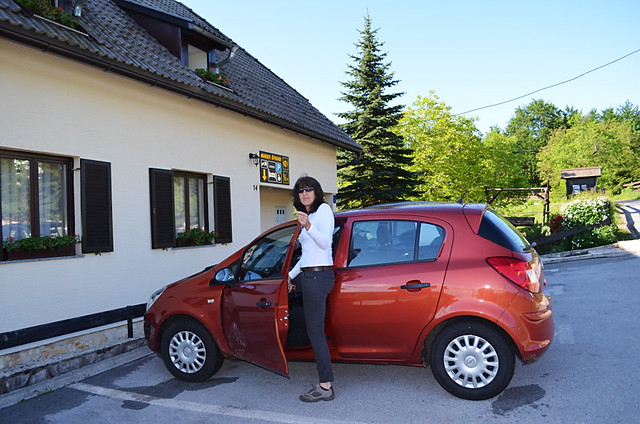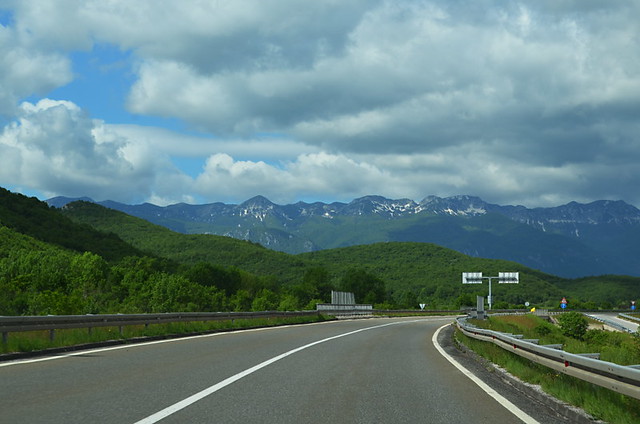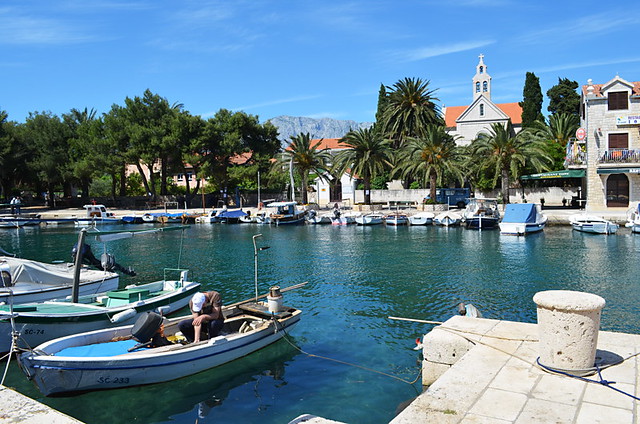“That’s our ferry” said Jack as we rounded another bend in the spellbindingly beautiful coast of Pelješac with its infinitesimal vineyards and champagne coloured stone hamlets.
Far below in the distance we could see a ferry moored alongside the quay and a row of vehicles slowly disappearing into its hull, like voluntary Jonahs into a whale. On instinct my foot pressed harder onto the accelerator but it was a futile gesture and we watched helplessly as the ferry slowly pulled away from the quay, turned, and set sail for Mljet just as we reached the access road to the ferry departure point.
Thirty seconds later we were on the quay, unsurprisingly, first in the vehicle queue for the next Mljet ferry. One check of the timetable pinned to the closed office window and it became clear that we were going to be alone in that queue for a very long time. The next ferry wasn’t for another five hours. We turned the car around, continued our journey along the Pelješac Peninsular and headed for Stön where we spent the next four hours exploring the town and enjoying a leisurely lunch before returning for the 5pm ferry to Mljet.
There are over 22,000 sq miles of Croatia to explore, including its host of islands that pepper the coast all the way from Istria to Dubrovnik. We took advantage of Ryanair’s low season fares to fly into Zadar in the Velebit region which gave us easy access to the island of Krk and to the Plitvice National Park. But we also wanted to explore Dubrovnik and the Dalmatian islands and the only way we could do all that in the time we had available, was by car.
Town and City Driving
The start of our driving on Croatia experience was a real baptism of fire for me, arriving into Zadar at 9.30am on a Monday morning and not having a clue where we were going as we’d forgotten to take a note of either the name or the address of where we were staying. Luckily for us, rush hour in Zadar was a bit like any hour in your average country town with no road rage, no endless queues and no impatient drivers ready to blast your heart into arrest at the first sign of hesitation or deviation. The roads are well signed, road users are considerate and in no time at all we’d found a wifi cafe, checked out where we were staying and were parking on the driveway of the apartment, ready to begin our Croatia adventure.
In Zadar, as in just about everywhere we stayed, once we’d arrived we parked the car and left it there until it was time to move on again, choosing to explore on foot. In Zadar, the old town is traffic free anyway so if you’re hiring a car, be sure to find accommodation in the new town or you’ll find yourself parted from your hire car. We stayed at Amico Apartments which had lots of parking space and was in easy strolling distance of the old town.
By the time we were heading into Dubrovnik almost a week later I was pretty well versed in the traffic systems but still a bit nervous about driving in such a huge, cosmopolitan centre. As it turned out, it was all very easy. Most hotels and apartments in Dubrovnik are well outside the old town walls. Ours, The Lapad, was overlooking Gruž port and was an easy find from the main Highway 8 which brings you into the city. Again, once there we just parked the car and left it until we were ready to leave, opting to use local buses to get in and out of the Old Town.
Coastal Driving
From Zadar, we drove north along the coastal road to take the road bridge to the island of Krk. Although scenically stunning, the coastal roads took forever to get where you were headed, mainly due to endless road works with temporary traffic lights. We figured that maybe there were a lot of improvements being undertaken before high season got under way but they were a long way off completion and that was in mid/late May. We found the same problem when we took the coastal road from the Pelješac Peninsular to Dubrovnik; jaw-dropping scenery to enjoy while you sat in yet another road works traffic jam.
Motorway Driving
Motorways in Croatia are toll based. You go through an automatic ticket barrier when you join the motorway and then pay your toll depending on how far you’ve travelled, when you leave. We only used the motorways twice but it was to travel practically the entire length of the country from Zadar to the south Dalmatian islands and back again. Our journey cost us just 99KN (£11/€13) each way and was a sound investment. For one thing, the speed limit on the motorway is a whopping 130km an hour so you really eat up the miles and for another, as they’re toll based they’re less busy than main roads. Admittedly it was early season when we were there but we found them to be almost devoid of traffic. They’re also pretty new and so the surfaces are good, even in rain we were able to maintain top speed most of our journey.
Island Driving
We only drove on a handful of islands in the time we were in Croatia but found similarities on them all. Usually there was just one central road running from north to south or east to west depending on the shape of the island. Sometimes the ‘main’ road could be narrow which made for some hairy moments as we drove around bends to face oncoming traffic nose to nose. On some islands, such as on Krk, the road was crammed with mobile homes and caravans which presumably will get worse as the season goes on.
The worst road we encountered was from Sucuraj to Hvar Town on the island of Hvar. We’d chosen to make the 35min, Drvenik to Sucuraj ferry crossing rather than the two hours Split to Stari Grad one and decided to have lunch in Sucuraj (below) to let the caravans and trailers move on before we drove to the other side of the island. Big mistake. Unbeknown to us, an eight kilometre stretch of the Sucuraj to Hvar road was undergoing major road works and the construction crew waited for what they assumed was the last of the ferry traffic to pass before entirely blocking the road with their JCBs. We drove seven kilometres over deep pitted, boulder strewn mess, dreading the moment when a tyre or two would burst, and then waited 40 minutes to get past the bulldozers. Hopefully by now the work will be finished, or at least, a lot better than when we were there.
It’s worth noting that ferry terminals are, in the main, in the middle of nowhere and it was common practice for foot passengers to try to get a lift from the car drivers while the ferry was docking. If you’re unlucky or don’t fancy trying your arm at cajoling someone into give you a lift, you could face a long walk to the nearest town to pick up a bus or coach connection.
For us, having a car in Croatia gave us the freedom and flexibility to go where we wanted, when we wanted, and if we needed to change plans at short notice there was no hanging around waiting for coaches or spending dead time at ferry terminals. Plus, it was an absolute joy to drive through such dramatically spectacular scenery. For anyone who enjoys driving, Croatia is a dream of a place to get behind the wheel. Our Opel Corsa hire car was brilliant too; it was nippy, just the right size for the two of us plus our luggage, easy to park and cost effective on fuel.
On the down side, parking can be an issue, particularly on the islands. We wanted to spend a morning exploring Korcula Town before leaving the island but after twice driving around, trying to find any space big enough to park our little five door, we gave up and went for the ferry instead. On Mljet we had to keep driving until the road pretty much ran out and then parked by some refuse bins, a five minute walk from our hotel. And if we were encountering those issues in May, what must it be like in August?
Some useful driving information for Croatia
- Drive on the right.
- Speed limits in built up areas 50kmh; on ordinary roads 90kmh; on dual carriageways 110kmh and on motorways 130kmh. If you’re towing a trailer the limit is 80kmh.
- To hire a car you need a full, valid driving licence.
- It’s illegal to use a mobile phone while driving without a hands-free device.
There are endless car hire companies operating in Croatia. Shop around for a good price (we rented a budget car through Rhinocarhire who act as an agent to get the best prices) and make sure you can collect and return at your destination airport. If you want someone else to make all the arrangements for you, check out Inntravel who feature a range of flydrive holidays to Croatia.
Andrea (Andy) Montgomery is a freelance travel writer and co-owner of Buzz Trips and The Real Tenerife series of travel websites. Published in The Telegraph, The Independent, Wexas Traveller, Thomas Cook Travel Magazine, EasyJet Traveller Magazine, you can read her latest content on Google+










Lovely article! I was doing something similar in the area only 2 years ago! Split is a lovely place!
Cheers, Daniel! We didn’t get to Split this time or to Vis which I believe is also excellent, two very good reasons for returning, don’t you think? 😉
Wow, really enjoyed reading this article and learnt so much about Croatia. I will certainly go for vacation with my wife.